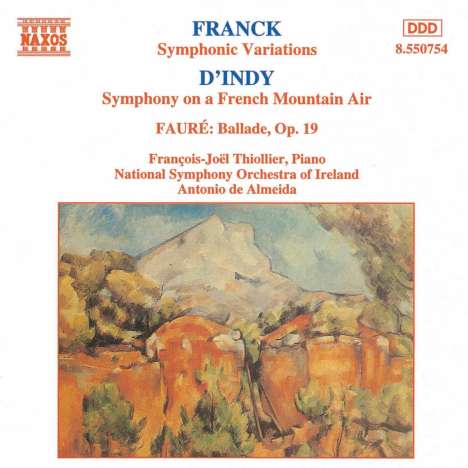Vincent d'Indy: Symphonie sur un chant montagnard français für Klavier & Orchester op.25 auf CD
Symphonie sur un chant montagnard français für Klavier & Orchester op.25
Herkömmliche CD, die mit allen CD-Playern und Computerlaufwerken, aber auch mit den meisten SACD- oder Multiplayern abspielbar ist.
Lassen Sie sich über unseren eCourier benachrichtigen, falls das Produkt bestellt werden kann.
+Franck: Symphonische Variationen
+Faure: Ballade op. 19
- Künstler:
- Francois-Joel Thiollier, Ireland National Symphony Orchestra, Antonio de Almeida
- Label:
- Naxos
- Aufnahmejahr ca.:
- 1993
- UPC/EAN:
- 0730099575423
- Erscheinungstermin:
- 27.5.1994
Ähnliche Artikel
Vincent d'Indys Symphonie sur un chant montagnard français, auch bekannt als Symphonie cévenole, aus der Quelle ihrer Inspiration, den Cevennen, wurde 1886 geschrieben. Sie ist für drei Flöten, zwei Oboen, ein Englischhorn, zwei Klarinetten, eine Bassklarinette, drei Fagotte, vier Hörner, Trompeten- und Kornettenpaare, drei Posaunen, Tuba, Pauken, Große Trommel, Becken und Triangel, Harfe, Streicher und Soloklavier geschrieben. Franck, Fauré und d'Indy bedienten sich allesamt relativ neuartiger Konstruktionstechniken, neuer Mittel zur Sicherung der musikalischen Einheit einer Komposition, die zum Teil von Liszts Methode der thematischen Metamorphose abgeleitet sind. Francks Symphonische Variationen, wie auch Faurés weniger gehaltvolle Ballade, verweben thematische Elemente, um diese Einheit zu bewirken.
Das Berglied, das Volksliedthema, auf dem die Sinfonie basiert, erklingt passend aus dem Englischhorn, begleitet von gedämpften Streichern im langsamen Einleitungsteil, wobei die Musik schneller wächst, wenn das Soloklavier von einer Ableitung des von Fagott, Cello und Kontrabass gespielten Liedes begleitet wird. Eine Klavierfassung des Themas führt zu einer lebhafteren Ausarbeitung dieses und verwandter Materialien, wobei der Satz mit der Rückkehr des Englischhorns endet, wiederum begleitet von gedämpften Streichern. Der zweite Satz, langsam, aber nicht zu langsam, bewegt sich von der Tonart G-Dur nach B-Dur, wobei die einleitenden Klavierphrasen von Flöte und Streichern bedeckt werden. Das Thema wird vom ganzen Orchester aufgegriffen und später, eine weitere Reminiszenz an Berlioz, einer Solobratsche anvertraut. Die ursprüngliche Tonart wird im animierten Finale mit seinen Verweisen auf das Vergangene wieder hergestellt.
Product Information
Vincent d'Indy's Symphonie sur un chant montagnard français, otherwise known as the Symphonie cévenole, from the source of its inspiration, the Cevennes, was written in 1886. It is scored for three flutes, two oboes, a cor anglais, two clarinets, a bass clarinet, three bassoons, four horns, pairs of trumpets and cornets, three trombones, tuba, timpani, bass drum, cymbals and triangle, harp, strings and solo piano. Franck, Fauré and d'Indy all made use of relatively novel structural techniques, new means of securing the musical unity of a composition, derived in part from Liszt's method of thematic metamorphosis. Franck's Symphonic Variations, like Fauré's less substantial Ballade, interweave thematic elements to effect this unity.
The mountain song, the folk-song theme on which the symphony is based, is appropriately heard from the cor anglais, accompanied by muted strings in the slow introductory section, the music growing faster as the solo piano is accompanied by a derivative of the song played by bassoon, cello and double bass. A piano version of the theme leads to a livelier elaboration of this and related material, the movement ending with the return of the cor anglais, again accompanied by muted strings. The second movement, slow, but not too slow, moves from the key of G major to B flat, the opening piano phrases capped by flute and strings. The theme is taken up by the whole orchestra and is later entrusted, a further reminiscence of Berlioz, to a solo viola. The original key is re-established in the animated finale, with its references to what has passed.
Disk 1 von 1 (CD)
-
1 Symphonic Variations
-
2 Ballade in F sharp major, Op. 19
-
3 Symphonie sur un chant montagnard francais, Op. 25, "Symphonie cevenole": I. Assez lent - Moderement anime
-
4 Symphonie sur un chant montagnard francais, Op. 25, "Symphonie cevenole": II. Assez modere, mais sans lenteur
-
5 Symphonie Sur Un Chant Montagnard Francais, Op. 25, "symphonie Cevenole": Iii. Anime







